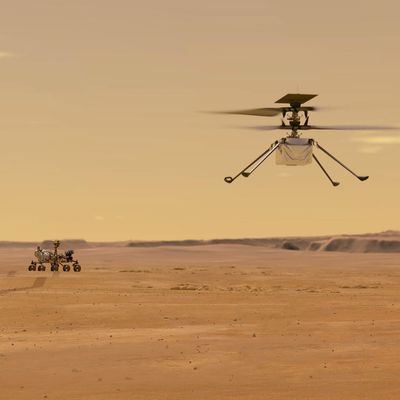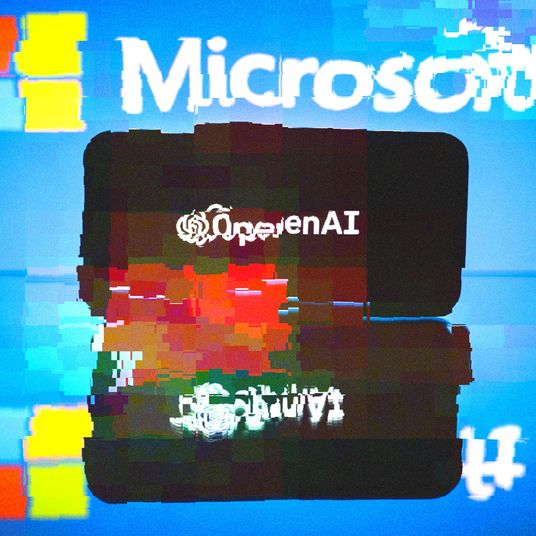
NASA’s Ingenuity helicopter finally took to the Martian skies in the wee hours of the morning on Monday, becoming the first ever rotorcraft to take flight on another world.
The four-pound solar-powered helicopter ascended to an altitude of ten feet above the Martian surface, hovered for 40 seconds, and then touched back down. Under Ingenuity’s solar panel is a tiny swath of wing fabric from the original Wright Brothers’ flyer, paying tribute to that first flight. Intelligencer spoke with Bobby Braun, the Jet Propulsion Laboratory’s director of planetary science, ahead of the flight about the historic mission.
What are some of the challenges of flying an aircraft on Mars?
There are quite a few. First of all, the atmosphere on Mars is about one-hundredth as thick as on Earth. When you fly, it’s all about generating lift. And lift is a function of the atmospheric density. So the fact that we have so much less density on Mars means we have to be super lightweight. Everything about Ingenuity’s design is based on minimizing its mass. The rotors themselves had to be specially designed for flight on Mars.
The second challenge really is that Ingenuity, while it’s an aircraft, it’s also a spacecraft. It had to be launched from Earth. It had to cruise through interplanetary space. It has to survive the challenging temperatures, very low temperatures on Mars.
Then the third challenge really is just the autonomous aspect. Mars is so far away that it takes approximately 14 minutes for a radio signal to reach from Earth to Mars. So we’re not flying it with a joystick, like if you had a drone in your backyard and you were flying it to take pictures of your house, right? Ingenuity is a fully autonomous system. In other words, we tell it, “Okay, tomorrow you’re going to fly and you’re going to go up ten feet and maybe you’re going to go off to the left or the right. You’re going to go downrange and come back and land.” We just tell it what it’s going to do and then it wakes up on its own and executes all of those commands autonomously. It has onboard cameras and other navigation instruments so that it can fly kind of like a pilot flies.
Ingenuity has experienced a few delays prior to its inaugural test flight. What happened?
Well, anytime you do something for the first time, particularly at a place like Mars, you’re going to encounter unknowns. We had a series of checkout tests that we were planning to do to get it ready for its first flight attempt, and on April 9, we didn’t pass one of those checkout tests. And what happened is the computers that control its flight didn’t boot up at the right time relative to the rest of the system.
Because Ingenuity is autonomous, when the timing is off, it knows something is wrong. To keep itself safe, it automatically shuts down, goes to sleep, and waits for commands from Earth for the next day. That takes some time, because you’ve got to send in the commands and Ingenuity’s got to receive those commands. The commands actually go to the Mars orbiters, which send the instructions down to the Perseverance rover, which transmits the instructions to the helicopter base station on the rover. And then the helicopter base station sends the commands to Ingenuity. All of that takes time. So, every time we do a test or an update of anything on Mars, it takes us about a day to do so.
If this test is successful, what could future helicopters for other planets do?
Well, first of all, if this test is successful, what we will have proven is that aerial flight on other planets is possible. If you go back in time, the first rover on Mars was a rover named Sojourner and it was carried to Mars along with the Mars Pathfinder mission, which landed in 1997. It was sent to Mars to prove what rovers could do. You can draw a straight line from the Sojourner mission in 1997 to Perseverance’s mission today. And I think in much of the same way that will be the path for helicopters; Ingenuity will pave the way for future missions.
There is actually a helicopter mission planned at Titan already, called Dragonfly. And even at Venus, we could fly helicopters. So any planet that has an appreciable atmosphere would be a possibility. In Mars, even, there are plenty of places that we’d like to explore like cliffs or very steep crater walls, but we can’t get to with rovers. A helicopter could, with some instrumentation, observe those locations and provide clues about Mars’s past and in doing so, about our own planet. Every time we go to Mars, we actually learn something about the Earth.





























